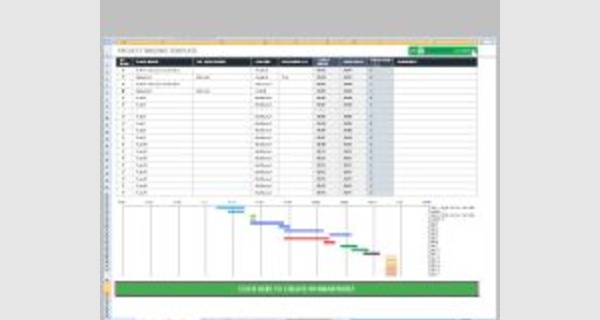Excel template timeline with milestones

Excel template timeline with milestones
This article provides details of Excel template timeline with milestones that you can download now.
Use the milestone chart template as a simpler way to illustrate, schedule and report your project. A milestone chart will provide a snapshot of your project for important presentations and communications with management or customers.
A timeline can be a useful way to visualize changes or events that occur over periods of time. Excel can be a great tool for creating timelines, particularly when you want to perform date calculations or take advantage of the drawing tools in Excel.
Microsoft Excel software under a Windows environment is required to use this template
These Excel templates timeline with milestones work on all versions of Excel since 2007.
Examples of a ready-to-use spreadsheet: Download this table in Excel (.xls) format, and complete it with your specific information.
To be able to use these models correctly, you must first activate the macros at startup.
The file to download presents three Excel template timeline with milestones
List your project milestones to automatically create a visual mapping of them in a timeline diagram using these templates.
...
WHAT IS A TIMELINE?
A Timeline is a visual method used to review major past events in a project, organization or community. Its objectives include establishing a common perspective and shared understanding among participants; reflecting on gaps, lessons and emerging trends; and supporting future planning for ongoing projects. Timelines are created through a group activity that enables participants to map out milestones, achievements, obstacles and other major developments together, and depict them in chronological order. This is followed by a plenary discussion to flesh out details and to validate the Timeline and the facts it includes. Timeline can be a good complement for other knowledge exchange tools, notably the Retrospect: Doing a Timeline as part of a Retrospect session is a good way to sharpen the group’s focus on the significant or critical moments that occurred during the implementation of a project/ initiative. This in turn helps identify the lessons to be learned. (See also the Retrospect elsewhere in this Toolbox.)
WHEN AND WHY TO USE
In the context of a long-term project, programme or initiative, one of the biggest challenges can be the lack of understanding of past developments and significant moments that have shaped the outcomes. Changes in staff and among partners often contribute to this gap, as persons with first-hand knowledge move on, and new people with a partial/limited understanding of past events take on their roles. And when a project or initiative faces a turning point – any moment where activities have to be reconfigured to meet new requirements – a sound understanding of how you got to that point is vital for making the right decisions and empowering effective action. With the help of key individuals who have the firsthand project knowledge needed to fill in the blanks, a Timeline helps to ‘lay all the cards on the table’ and provides a complete contextual overview for participants.
But it is not only ongoing initiatives that can benefit from a Timeline. Undertaking new initiatives also requires an understanding of the current situation, and why it has come to be what it is. All situations or problems, in all communities, have a history of significant past events that have shaped the present reality. In these cases, the timeline is used as a planning tool, by establishing a shared understanding of the past and then identifying the significant milestones that the project is expected to achieve in the short and medium term.
The Timeline can be used to:
- Bring all team members up to speed on a project’s/initiative’s history, ensuring that everyone has the same information and has a chance to understand others’ perspectives. This in turn builds a common understanding of the activity, and strengthens the connections among people working on it.
- Understand any current situation (not limited to your own projects/initiatives) by analyzing how developments over time contributed to it. Help identify weaknesses or gaps by comparing the project’s original intentions with how it actually unfolded.
- Help to identify practical solutions for a recurring problem, by examining its causes and the impacts of efforts to mitigate it.
- Strengthen strategic planning, through the insights that the Timeline process provides, e.g., recognizing trends, and responding or taking advantage of them in future plans.
- Learn lessons from experience.
- Understand the present challenges faced by a community by examining the impact of changing socio-economic and other factors over an extended period of time.
HOW TO APPLY
Prepare in advance These instructions are for event organizers.
- Decide on the objective of the Timeline exercise. Refer to the list of ways to apply the Timeline given above, under ‘When and why to use’
- Plan for appropriate facilitation. The facilitator plays a major role in guiding the Timeline process. Ideally, s/he should be appropriately skilled, aware of the subject matter and genuinely interested in digging into the history of a project, situation or community challenge, but should not offer their own substantive views on the subject during the discussion. Persons with strong views that they want to express should be participants, not facilitators
- Invite participants. If you are focusing on a particular project or initiative, invite a broad cross-section of the relevant staff and partners involved in it, up to about 20 people. Share the objective with all prospective participants, describe the benefits and the reason you need their participation, and give them an idea of the intended outputs. Invite both persons involved in current and future action, as well as those involved in the past, since the inception of the project, even if they are not currently working on it. Persons with past experience in the project will provide the institutional memory that is essential for a successful Timeline exercise
- Book a large room. You will need sufficient space to post the timeline sheets so that participants can write on them
Set up the room
These instructions are for event facilitators.
- Put up the Timeline sheets. Do so before participants arrive. Use several large sheets of flipchart paper placed side by side, and put them up prominently in such a way that participants can write on them.
- The total length of the flipchart papers should reflect the time period and events/ activities to be added. Make sure the flipchart landscape is wide enough to accommodate enough of the complexities of the project and the level of detail sought. You can even post a double row of papers if you need lots of space.
- You can put up the Timeline papers by taping them on a meeting room wall. Look for a long, clear wall with no obstructions; avoid using walls with built-in cabinets or shelves. Make sure the layer of papers is thick enough to prevent the markers bleeding through to the walls.
- If you cannot use the walls, then pin the flipchart papers to pin boards. You will likely need at least four pin boards placed side by side. Cover them with flipchart papers to create a continuous landscape. Make sure there is enough room for people to walk from one end to the other.
When you are ready to start These instructions are for event facilitators.
- Begin by providing context. State the purpose of the Timeline exercise and the time period being explored (past, or past and future). Draw a horizontal line on the Timeline sheets, and mark a few relevant dates: the beginning, the end, and a few in between
- Kick off the discussion with a few guiding questions. The questions will help participants identify, from their own experience, the significant milestones or events (both positive and negative) that have contributed to advance or set back the project. Questions to use include:
- What were the key past developments that have shaped the present? What were the notable milestones? Were there any turning points, where events took a decidedly positive or negative turn?
- Who were the actors or stakeholders whose actions impacted the key developments, or helped bring them about?
- What were key external factors or events that affected the project?
- What were the major obstacles to success/progress? How were the obstacles overcome? Or are any of them recurring?
- Ask participants to respond to the questions individually. Assign post-it note colours for key categories (events, actors/stakeholders, external factors, obstacles, etc.). Have participants write their answers on appropriately coloured post-its, and have them put the post-its where they think they belong on the timeline. Everyone can do this at the same time
- When the flow of answers slackens and the timeline is well populated, begin the group discussion. Start at the beginning and go over all of the post-its to the end of the timeline. Ask participants to confirm the dates of the events, to group relevant actors/stakeholders with events, to move post-its around and to add additional key events, actors, obstacles, etc. as they recall them (by writing additional post-its and placing them where appropriate on the timeline).
- As you work your way through processing the post-its already submitted, keep the discussion open and allow participants to add more post-its at any point. Let the discussion proceed organically.
- Participants should confer about the facts of the past, who did what and when it happened – but if there is disagreement, do not force a conclusion, since there may be legitimately different interpretations. In this situation you may need to have multiple post-its to reflect different views of a single event/actor, and to return to these in subsequent discussion.
- You can also add a few relevant details (to flesh out an event, actor, etc.) on the timeline, either on post-its or written on the flipchart paper itself.
- Keep an eye on participation levels. If there are any very quiet participants, or dominant ones, then consider breaking into smaller groups for quick discussions so that everyone can participate. (See Buzz Groups elsewhere in this Toolbox.)
- Validate the timeline. Once you have reached the end of the timeline, go back to any issues that require further plenary discussion or clarification. Ask participants to confirm that all major events, actors, etc. have been captured, and make any necessary additions. Capture the timeline in photos for future reference (a cellphone camera is fine). A validated timeline serves as a useful basis for future planning and action
- Optional: Use the validated timeline to support a process of reflection on past actions. If you are combining the Timeline tool with a Retrospect or other reflective method such as After Action review, then use the validated Timeline to help the group more clearly identify what worked well, what could have worked better and useful recommendations for future action. You can ask participants to focus on the moments that have been confirmed as most critical for the project, and follow up in groups or in plenary with specific analytical questions (see Retrospect in this Toolbox
- Optional: To support future planning and decision-making in an ongoing project, extend the timeline into the future. This will help the group answer the question, ‘Where do we want to take this project?’ Continue the discussion: Ask participants to identify the key upcoming milestones needed for success, the approximate timeframe for them, plus any likely future challenges and opportunities that are expected based on past events and the current situation. You can also prompt participants to consider which stakeholders would need to be involved in the future, what specific deliverables are required for each milestone, and the external factors and potential obstacles to watch out for at specific times.
